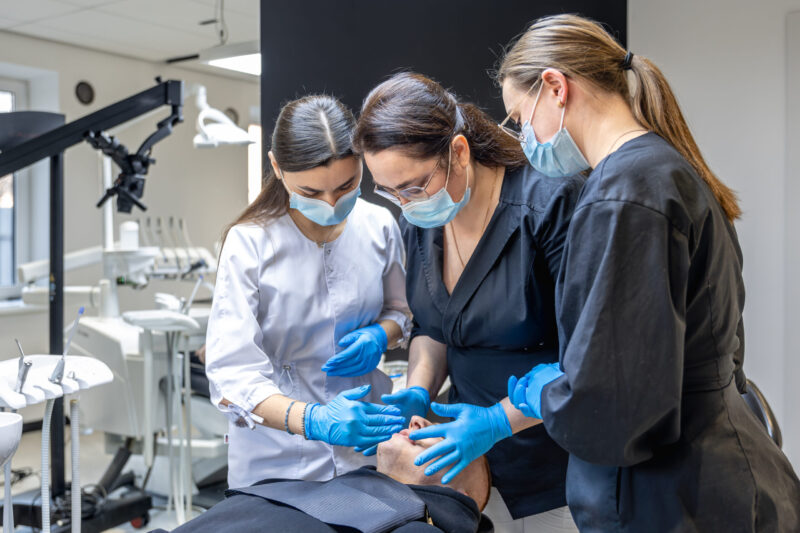
Getting a dental implant is one of the best ways to replace a missing tooth and restore your smile. However, not every patient has a jawbone healthy enough to support the implant. This is where a bone graft is important.
A bone graft strengthens and rebuilds the jaw so that it can hold the implant securely. Understanding how a bone graft works and what to expect during healing will help you prepare for a successful treatment.
Today, we will uncover all the information you need to know about the bone graft for dental implant procedure.
What Is a Bone Graft?
A bone graft is a procedure that adds or restores the bone in the jaw. In dentistry, it is used when bone is too thin or too weak to support a tooth implant. The graft material can come from your own body, from a donor or from a synthetic source. Over time, the graft fuses with your natural bone, creating a strong foundation for a dental implant.
There are several types of bone grafts. An autograft uses bone from your own body. An allograft comes from a human donor. A xenograft comes from an animal source, usually bovine. An alloplast is a synthetic graft made of safe materials. Your dentist will recommend the best type of material for your oral health situation.
Bone Graft for Tooth Implant – Why Is It Needed?
Bone loss in the jaw is more common than many people realize. When a tooth is missing, the bone underneath can shrink over time. Gum disease or infection can also weaken the bone. A weak jawbone cannot properly hold a dental implant, which can lead to failure.
A bone graft for tooth implant restores the strength and thickness of the bone. This gives the implant a stable base and helps ensure long-lasting results. Patients who receive a graft before an implant often enjoy better function and a natural look that blends with their smile.
Bone Graft for Dental Implant: The Procedure Explained
The process begins with a consultation with a dental bone graft specialist. The specialist will examine your mouth by taking digital scans and determine the amount of bone needed.
Then, during the procedure local anesthesia or sedation is used to keep you comfortable. The specialist places the graft material in the area where bone is missing. In some cases, a protective membrane is also placed to help with healing. The site on your jaw is then closed with stitches.
Once the graft is in place, your body starts the natural healing process. Over the next several months, the graft material fuses with your bone. This process creates a strong foundation for future implants.
Dental Bone Graft Healing Stages
Healing from a dental bone graft takes time and goes through several stages.
Stage one: Initial healing
In the first couple of weeks you may notice swelling or minor discomfort. This is normal and can be managed with medication and proper aftercare.
Stage two: Bone regeneration
During the first to three months, the graft material stimulates your body to grow new bone. The area becomes stronger as the natural bone fills in.
Stage three: Full integration
Three to six months, the graft becomes fully integrated with your natural bone. At this stage the jaw is usually strong enough to support a dental implant.
Healing time can vary depending on your age, health, smoking habits and oral hygiene. Following your dentist’s instructions closely helps the bone graft heal faster and with fewer complications.
Bone Graft for Implant – How Long Before You Can Get an Implant
Most patients need to wait three to six months after a bone graft before receiving an implant. This waiting period allows the graft to fully integrate with the jawbone. In some cases where bone loss is minimal, an implant may be placed at the same time as the graft.
Patience is important during this process. Rushing to place an implant before the bone is ready can reduce the chances of success. A dental bone graft specialist will guide you on the right timing for your implant.
Why Choose a Dental Bone Graft Specialist
Not all dentists perform bone grafts. Choosing a dental bone graft specialist ensures you receive expert care. These specialists have advanced training in bone and implant procedures. Our professional dentists at Pannu Dental Group know how to perform bone grafts for tooth implants with precision and care, ensuring long-lasting results.
They also use modern technology, such as 3D imaging and guided surgery tools. This improves accuracy and reduces the risk of complications. A specialist will create a custom treatment plan based on your needs and provide a greater chance of long-term success.
When meeting with your dental specialist, ask about their experience, the types of grafts they use and the success rates of their implant cases. The right dental provider will answer your questions and make you feel comfortable with the procedure.
Important Points About Dental Bone Grafts
Is a bone graft painful?
Most patients feel little to no pain during the procedure because of anesthesia. Mild soreness afterward can be managed with medication.
How long does recovery take?
Initial recovery takes one to two weeks. Full healing may take several months.
Can a graft fail?
Yes, although it is very rare. Following aftercare instructions and choosing an experienced specialist reduces the risk.
Are there alternatives to bone grafting?
In some cases, short implants or angled implants can be used, but these are not always suitable for every patient.
How much does a dental bone graft cost?
The cost depends on the type of graft and the complexity of the procedure. A consultation with a dental bone graft specialist will give you a clear estimate.
Strengthen Your Implant Success with Bone Graft for Tooth Implant
A bone graft for tooth implant is often the key step for patients who want strong and stable dental implants. By rebuilding the bone in your jaw, the graft creates the secure foundation needed for a long-lasting smile. When you understand the procedure and the healing stages, then you can move forward with confidence, knowing what to expect.
At Pannu Dental Group, our professional implant specialists in San Jose and across the Bay Area know how to perform bone grafts with precision and care. Not all dentists perform bone grafts, which is why choosing an experienced dental bone graft specialist matters the most.
Our team combines advanced training and modern technology to create custom treatment plans that lead to higher success rates and healthier smiles.
Take the next step toward your implant journey today.
Schedule a consultation with Pannu Dental Group and discover how a bone graft for tooth implant can give you the strong foundation you need for a confident smile.
Dr. Dalvir S. Pannu has been a practicing dentist since 1995. In 1996 he opened his first dental practice in India, where he gained invaluable experience and acumen. In October of 1997 he was invited by the American Dental Association (ADA) to present the table clinic on Endodontics, at their annual session held in Washington, D.C. At this time he fell in love with the United States and became passionate about practicing dentistry in California. He became particularly enamored of the San Francisco Bay area, and soon took up residence and work here.
